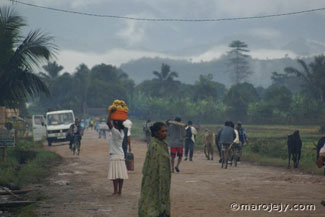 |
|||||
|
According to local lore, Andapa was first settled (in Andapahely) sometime around 1830 by a certain Tsimandratra and his wife Helivola. Tsimandratra performed the rites required by the great invisible powers so they could grant his wish to settle in the area, and he became Zafitany, official owner and lord of the earth and the region. Others, having received the blessings of Zafitany, one by one joined these first settlers. Andapa was born. While the first inhabitants were from the Tsimihety ethnic group, originating from the northern interior regions of Befandriana, Mandritsara, and even Bealana, the people who followed in later years arrived from many different places. Andapa's ideal climate, cooler and less rainy than the hot and muggy coast, and the fertile soils of the Andapa Basin provided a more comfortable life and were powerful draws. Living in harmony with a benign and generous environment, the population grew from isolated huts into tiny hamlets, and from hamlets into villages. Today, the population of the area is growing at a very high rate, doubling every 25–30 years. The first appearance of the French colonists wasn't until the years 1910–1920, well after they had seized control of the island in 1896 (when Queen Ranavalona III had been forced into exile in Algeria). Most of the colonists in the Andapa area were originally from the Island of Réunion, and came to establish agricultural enterprises, particularly to grow coffee, vanilla and other products for foreign export. Large tracts of forest were cut down for these large-scale ventures.
The people of the Andapa area are amazingly warm and friendly, always smiling, always generous in their actions. While farming is the main occupation in the Basin, it is the thousands of tiny shops found along every road and path that bind the community together: these are the meeting places, full of non-stop animation. The diversity and the liveliness of the people can be seen in the little businesses, from the baker to the blacksmith, from the auto repairman to the veterinarian, from the "hotelys" (tiny restaurants serving the traditional plate of rice) to the hawkers pushing their carts of merchandise, from the streams of bicycles transporting the harvests to the men herding zebu cattle… Life is there, swarming, teeming, careless in the indifferent gentleness of the days… Many local people, regardless of their Malagasy ethnic origins, observe a number of "fadys," or taboos, and often hold beliefs similar to traditional animists – "fombas" or traditions regarding the ancestors, their memories and their stories. Nevertheless, organized religion holds a firm place in the lives of most Malagasy people, regardless of what they might profess elsewhere. While the majority of people call themselves Catholic or Protestant, a significant number belong to other religious groups, including Islam, Seventh Day Adventist (which runs the best hospital in Andapa), Jehovah's Witness, Lutheran, and others.
But witchcraft, secret rites, spell casting, fortune telling, and other mystical activities are always there, hidden just under the surface. When traditional religion doesn't provide an anticipated answer, one can always revert back to these ancestral beliefs at the time of last hope. These beliefs also act as a type of social glue that bonds individuals together. Like everywhere in Madagascar, ancestor worship is important. Death represents a state. However, tombs are not as numerous in Andapa as elsewhere, mostly because Andapa has been settled relatively recently. The burials of the "fasandrazana" (the family line leading to the original ancestor) found around Mananara, Maroantsetra or in the Androna are replaced in Andapa by smaller tombs representing the "taranaka" – a shorter family line but showing the same longing for roots held by the people in the Andapa region.
|
||||


